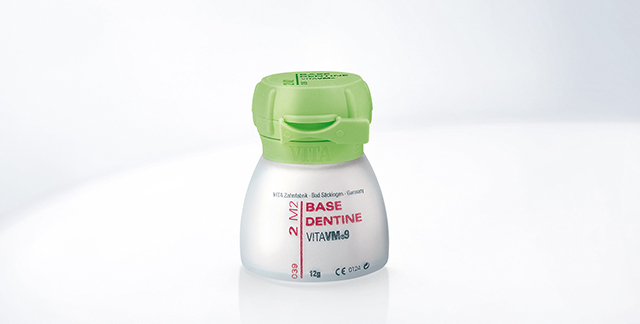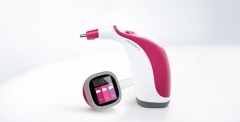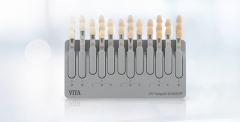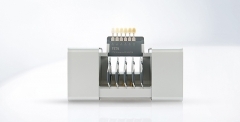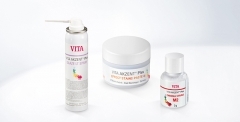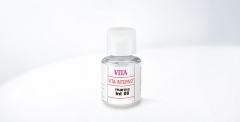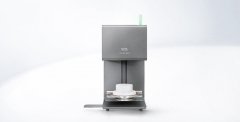VITA VM 9 is a highly-esthetic, fine-structure feldspar ceramic that is perfectly adapted to the CTE value of zirconia frameworks (approx. 10.5, e.g. such as VITA YZ) – regardless of whether they are white, colored or translucent.
It is also recommended for customizing restorations made from VITABLOCS Mark II.
Esthetic
A vibrant play of colors, thanks to enamel-like light refraction and reflection.
Reliable
Excellent bonding ensures reliable results
Resistance
The extremely homogeneous fine structure ensures a smooth and sealed surface.
VITAVM®9 VITA classical A1-D4®
VITA VM 9 BASE DENTINE, 12 g / 50 g
|
Description
|
Powder no.
|
Prod. no. 12 g
|
Prod. no. 50 g
|
|---|
|
A1
|
ENL
|
B4243112
|
B4243150
|
|
A2
|
ENL
|
B4243212
|
B4243250
|
|
A3
|
ENL
|
B4243312
|
B4243350
|
|
A3.5
|
END
|
B4243412
|
B4243450
|
|
A4
|
END
|
B4243512
|
B4243550
|
|
B1
|
END
|
B4243612
|
B4243650
|
|
B2
|
END
|
B4243712
|
B4243750
|
|
B3
|
END
|
B4243812
|
B4243850
|
|
B4
|
END
|
B4243912
|
B4243950
|
|
C1
|
END
|
B4244012
|
B4244050
|
|
C2
|
END
|
B4244112
|
B4244150
|
|
C3
|
ENL
|
B4244212
|
B4244250
|
|
C4
|
ENL
|
B4244312
|
B4244350
|
|
D2
|
END
|
B4244412
|
B4244450
|
|
D3
|
END
|
B4244512
|
B4244550
|
|
D4
|
END
|
B4244612
|
B4244650
|
VITA VM 9 TRANSPA DENTINE, 12 g / 50 g
|
Description
|
Powder no.
|
Prod. no. 12 g
|
Prod. no. 50 g
|
|---|
|
A1
|
ENL
|
B4245112
|
B4245150
|
|
A2
|
ENL
|
B4245212
|
B4245250
|
|
A3
|
ENL
|
B4245312
|
B4245350
|
|
A3.5
|
END
|
B4245412
|
B4245450
|
|
A4
|
END
|
B4245512
|
B4245550
|
|
B1
|
END
|
B4245612
|
B4245650
|
|
B2
|
END
|
B4245712
|
B4245750
|
|
B3
|
END
|
B4245812
|
B4245850
|
|
B4
|
END
|
B4245912
|
B4245950
|
|
C1
|
END
|
B4246012
|
B4246050
|
|
C2
|
END
|
B4246112
|
B4246150
|
|
C3
|
ENL
|
B4246212
|
B4246250
|
|
C4
|
ENL
|
B4246312
|
B4246350
|
|
D2
|
END
|
B4246412
|
B4246450
|
|
D3
|
END
|
B4246512
|
B4246550
|
|
D4
|
END
|
B4246612
|
B4246650
|
VITAVM®9 VITA SYSTEM 3D-MASTER®
VITA VM 9 BASE DENTINE, 12 g / 50 g
|
Description
|
Powder no.
|
Prod. no. 12 g
|
Prod. no. 50 g
|
|---|
|
0M1
|
ENL
|
B4203112
|
B4203150
|
|
0M2
|
ENL
|
B4203212
|
B4203250
|
|
0M3
|
ENL
|
B4203312
|
B4203350
|
|
1M1
|
ENL
|
B4203412
|
B4203450
|
|
1M2
|
ENL
|
B4203512
|
B4203550
|
|
2L1.5
|
ENL
|
B4203612
|
B4203650
|
|
2L2.5
|
ENL
|
B4203712
|
B4203750
|
|
2M1
|
ENL
|
B4203812
|
B4203850
|
|
2M2
|
ENL
|
B4203912
|
B4203950
|
|
2M3
|
ENL
|
B4204012
|
B4204050
|
|
2R1.5
|
ENL
|
B4204112
|
B4204150
|
|
2R2.5
|
ENL
|
B4204212
|
B4204250
|
|
3L1.5
|
ENL
|
B4204312
|
B4204350
|
|
3L2.5
|
ENL
|
B4204412
|
B4204450
|
|
3M1
|
ENL
|
B4204512
|
B4204550
|
|
3M2
|
ENL
|
B4204612
|
B4204650
|
|
3M3
|
ENL
|
B4204712
|
B4204750
|
|
3R1.5
|
ENL
|
B4204812
|
B4204850
|
|
3R2.5
|
ENL
|
B4204912
|
B4204950
|
|
4L1.5
|
END
|
B4205012
|
B4205050
|
|
4L2.5
|
END
|
B4205112
|
B4205150
|
|
4M1
|
END
|
B4205212
|
B4205250
|
|
4M2
|
END
|
B4205312
|
B4205350
|
|
4M3
|
END
|
B4205412
|
B4205450
|
|
4R1.5
|
END
|
B4205512
|
B4205550
|
|
4R2.5
|
END
|
B4205612
|
B4205650
|
|
5M1
|
END
|
B4205712
|
B4205750
|
|
5M2
|
END
|
B4205812
|
B4205850
|
|
5M3
|
END
|
B4205912
|
B4205950
|
VITA VM 9 TRANSPA DENTINE, 12 g / 50 g
|
Description
|
Powder no.
|
Prod. no. 12 g
|
Prod. no. 50 g
|
|---|
|
0M1
|
ENL
|
B4206112
|
B4206150
|
|
0M2
|
ENL
|
B4206212
|
B4206250
|
|
0M3
|
ENL
|
B4206312
|
B4206350
|
|
1M1
|
ENL
|
B4206412
|
B4206450
|
|
1M2
|
ENL
|
B4206512
|
B4206550
|
|
2L1.5
|
ENL
|
B4206612
|
B4206650
|
|
2L2.5
|
ENL
|
B4206712
|
B4206750
|
|
2M1
|
ENL
|
B4206812
|
B4206850
|
|
2M2
|
ENL
|
B4206912
|
B4206950
|
|
2M3
|
ENL
|
B4207012
|
B4207050
|
|
2R1.5
|
ENL
|
B4207112
|
B4207150
|
|
2R2.5
|
ENL
|
B4207212
|
B4207250
|
|
3L1.5
|
ENL
|
B4207312
|
B4207350
|
|
3L2.5
|
ENL
|
B4207412
|
B4207450
|
|
3M1
|
ENL
|
B4207512
|
B4207550
|
|
3M2
|
ENL
|
B4207612
|
B4207650
|
|
3M3
|
ENL
|
B4207712
|
B4207750
|
|
3R1.5
|
ENL
|
B4207812
|
B4207850
|
|
3R2.5
|
ENL
|
B4207912
|
B4207950
|
|
4L1.5
|
END
|
B4208012
|
B4208050
|
|
4L2.5
|
END
|
B4208112
|
B4208150
|
|
4M1
|
END
|
B4208212
|
B4208250
|
|
4M2
|
END
|
B4208312
|
B4208350
|
|
4M3
|
END
|
B4208412
|
B4208450
|
|
4R1.5
|
END
|
B4208512
|
B4208550
|
|
4R2.5
|
END
|
B4208612
|
B4208650
|
|
5M1
|
END
|
B4208712
|
B4208750
|
|
5M2
|
END
|
B4208812
|
B4208850
|
|
5M3
|
END
|
B4208912
|
B4208950
|
VITAVM®9 additional powder
compatible with VITA SYSTEM 3D-MASTER and VITA classical A1-D4 shades
VITA VM 9 EFFECT ENAMEL, 12 g
|
Description
|
Prod. no. 12 g
|
|---|
|
EE1
|
B4209112
|
|
EE2
|
B4209212
|
|
EE3
|
B4209312
|
|
EE4
|
B4209412
|
|
EE5
|
B4209512
|
|
EE6
|
B4209612
|
|
EE7
|
B4209712
|
|
EE8
|
B4209812
|
|
EE9
|
B4209912
|
|
EE10
|
B4210012
|
|
EE11
|
B4210112
|
VITA VM 9 EFFECT CHROMA, 12 g
|
Description
|
Prod. no. 12 g
|
|---|
|
EC1
|
B4212112
|
|
EC2
|
B4212212
|
|
EC3
|
B4212312
|
|
EC4
|
B4212412
|
|
EC5
|
B4212512
|
|
EC6
|
B4212612
|
|
EC7
|
B4212712
|
|
EC8
|
B4212812
|
|
EC9
|
B4212912
|
|
EC10
|
B4213012
|
|
EC11
|
B4213112
|
VITA VM 9 EFFECT LINER, 12 g
|
Description
|
Prod. no. 12 g
|
|---|
|
EL1
|
B4214112
|
|
EL2
|
B4214212
|
|
EL3
|
B4214312
|
|
EL4
|
B4214412
|
|
EL5
|
B4214512
|
|
EL6
|
B4214612
|
VITA VM 9 EFFECT PEARL, 12 g
|
Description
|
Prod. no. 12 g
|
|---|
|
EP1
|
B4215112
|
|
EP2
|
B4215212
|
|
EP3
|
B4215312
|
|
Description
|
Prod. no. 12 g
|
|---|
|
MM1
|
B4216112
|
|
MM2
|
B4216212
|
|
MM3
|
B4216312
|
VITA VM 9 EFFECT OPAL, 12 g
|
Description
|
Prod. no. 12 g
|
|---|
|
EO1
|
B4217112
|
|
EO2
|
B4217212
|
|
EO3
|
B4217312
|
|
EO4
|
B4217412
|
|
EO5
|
B4217512
|
VITA VM 9 WINDOW, 12 g / 50 g / 250 g
|
Description
|
Prod. no. 12 g
|
Prod. no. 50 g
|
Prod. no. 250 g
|
|---|
|
WIN
|
B4218112
|
B4218150
|
B42181250
|
VITA VM 9 ENAMEL, 12 g / 50 g / 250 g
|
Description
|
Prod. no. 12 g
|
Prod. no. 50 g
|
Prod. no. 250 g
|
|---|
|
ENL
|
B4219112
|
B4219150
|
B42191250
|
|
END
|
B4219212
|
B4219250
|
B42192250
|
VITA VM 9 NEUTRAL, 12 g / 50 g / 250 g
|
Description
|
Prod. no. 12 g
|
Prod. no. 50 g
|
Prod. no. 250 g
|
|---|
|
NT
|
B4220112
|
B4220150
|
B42201250
|
VITA VM 9 EFFECT BONDER, 12 g
|
Description
|
Prod. no. 12 g
|
|---|
|
EB0
|
B4221012
|
|
EB1
|
B4221112
|
|
EB2
|
B4221212
|
|
EB3
|
B4221312
|
|
EB4
|
B4221412
|
|
EB5
|
B4221512
|
VITA VM 9 CORRECTIVE, 12 g
|
Description
|
Prod. no. 12 g
|
|---|
|
COR1
|
B4222112
|
|
COR2
|
B4222212
|
|
COR3
|
B4222312
|
|
Description
|
Prod. no. 12 g
|
|---|
|
G1
|
B4223112
|
|
G2
|
B4223212
|
|
G3
|
B4223312
|
|
G4
|
B4223412
|
|
G5
|
B4223512
|
VITA VM 9 CHROMA PLUS, 12 g
|
Description
|
Prod. no. 12 g
|
|---|
|
CP1
|
B4224112
|
|
CP2
|
B4224212
|
|
CP3
|
B4224312
|
|
CP4
|
B4224412
|
|
CP5
|
B4224512
|
|
Description
|
Prod. no. 12 g
|
|---|
|
M1
|
B4226112
|
|
M4
|
B4226412
|
|
M5
|
B4226512
|
|
M7
|
B4226712
|
|
M8
|
B4226812
|
|
M9
|
B4226912
|
|
Description
|
Prod. no. 12 g
|
|---|
|
ADD1
|
B4229112
|
|
ADD2
|
B4229212
|
|
ADD3
|
B4229312
|
|
ADD4
|
B4229412
|
|
ADD5
|
B4229512
|
|
ADD6
|
B4229612
|
|
ADD7
|
B4229712
|
|
ADD8
|
B4229812
|
VITA VM 9 SUN DENTINE, 12 g
|
Description
|
Prod. no. 12 g
|
|---|
|
SD1
|
B4236112
|
|
SD2
|
B4236212
|
|
SD3
|
B4236312
|
VITAVM®9 VITA classical A1-D4®
|
|
VITAVM®9 BUILD UP KIT
VITA classical A1-D4® Build-up kit for BUILD UP layering
BV9BUK12CV1
|
Quantity
|
Content
|
Material
|
|---|
|
16
|
12 g
|
VITA VM 9 TRANSPA DENTINE A1 - D4
| |
1
|
50 ml
|
VITA MODELLING FLUID RS
|
|
|
|
VITAVM®9 ONE COLOR KIT A2 One-shade kit for initial tests
BV9OCKA2V4
|
Quantity
|
Content
|
Material
|
|---|
|
1
|
12 g
|
VITA VM 9 CHROMA PLUS CP2
| |
1
|
12 g
|
VITA VM 9 BASE DENTINE A2
| |
1
|
12 g
|
VITA VM 9 ENAMEL ENL
| |
1
|
12 g
|
VITA VM 9 WINDOW WIN
| |
1
|
5 g
|
VITA AKZENT Plus GLAZE POWDER
| |
1
|
50 ml
|
VITA MODELLING FLUID RS
| |
1
|
20 ml
|
VITA AKZENT Plus POWDER FLUID
|
|
VITAVM®9 VITA SYSTEM 3D-MASTER®
|
|
VITAVM®9 BUILD UP KIT
VITA SYSTEM 3D-MASTER® Build-up kit for BUILD UP layering
BV9BUK12V1
|
Quantity
|
Content
|
Material
|
|---|
|
26
|
12 g
|
VITA VM 9 TRANSPA DENTINE 1M1 - 1M2, 2L1.5 - 2L2.5, 2M1 - 2M3, 2R1.5 - 2R2.5, 3L1.5 - 3L2.5, 3M1 - 3M3, 3R1.5 - 3R2.5, 4L1.5 - 4L2.5, 4M1 - 4M3, 4R1.5 - 4R2.5, 5M1 - 5M3
| |
1
|
50 ml
|
VITA MODELLING FLUID RS
|
|
|
|
VITAVM®9 ONE COLOR KIT 2M2 One-shade kit for initial tests
BV9OCK2M2V5
|
Quantity
|
Content
|
Material
|
|---|
|
1
|
12 g
|
VITA VM 9 CHROMA PLUS CP2
| |
1
|
12 g
|
VITA VM 9 BASE DENTINE 2M2
| |
1
|
12 g
|
VITA VM 9 ENAMEL ENL
| |
1
|
12 g
|
VITA VM 9 WINDOW WIN
| |
1
|
5 g
|
VITA AKZENT Plus GLAZE POWDER
| |
1
|
50 ml
|
VITA MODELLING FLUID RS
| |
1
|
20 ml
|
VITA AKZENT Plus POWDER FLUID
|
|
VITAVM®9 additional powder
compatible with VITA SYSTEM 3D-MASTER and VITA classical A1-D4 shades
|
|
VITAVM®9 ESTHETIC KIT
for VITABLOCS for CEREC Additional materials for customizing VITABLOCS
BV9EKCV2
|
Quantity
|
Content
|
Material
|
|---|
|
1
|
|
VITABLOCS Mark II Sample Set VITA SYSTEM 3D-MASTER
| |
1
|
12 g
|
VITA VM 9 WINDOW WIN
| |
1
|
12 g
|
VITA VM 9 NEUTRAL NT
| |
2
|
12 g
|
VITA VM 9 ENAMEL ENL, END
| |
1
|
12 g
|
VITA VM 9 EFFECT PEARL EP1
| |
2
|
12 g
|
VITA VM 9 EFFECT ENAMEL EE1, EE10
| |
1
|
12 g
|
VITA VM 9 CORRECTIVE COR1
| |
1
|
4 g
|
VITA AKZENT Plus FINISHING AGENT PASTE
| |
1
|
4 g
|
VITA AKZENT Plus GLAZE PASTE
| |
1
|
12 g
|
VITA VM 9 EFFECT OPAL EO2
| |
2
|
12 g
|
VITA VM 9 EFFECT CHROMA EC1, EC4
| |
1
|
12 g
|
VITA VM 9 MAMELON MM2
| |
1
|
50 ml
|
VITA MODELLING FLUID RS
| |
1
|
15 ml
|
VITA AKZENT Plus PASTE FLUID
| |
1
|
|
Firing tray W for crowns and bridges
| |
1
|
|
2 Platinum pins (1 anterior and 1 posterior pin)
|
|
|
|
VITAVM®9 GINGIVA KIT Natural-looking gingiva pastes
BV9GKV1
|
Quantity
|
Content
|
Material
|
|---|
|
5
|
12 g
|
VITA VM 9 GINGIVA G1 - G5
| |
1
|
|
Shade guide for VITA VM GINGIVA / MARGIN
|
|
|
|
VITAVM®9 MARGIN KIT Only for minor corrections in the area of margins
BV9MKV1
|
Quantity
|
Content
|
Material
|
|---|
|
6
|
12 g
|
VITA VM 9 MARGIN M1, M4 - M5, M7 - M9
| |
1
|
|
Shade guide for VITA VM GINGIVA / MARGIN
|
|
|
|
VITAVM®9 PROFESSIONAL KIT Additional materials for achieving special shade effects and
individualizing the restoration
BV9PKV2
|
Quantity
|
Content
|
Material
|
|---|
|
11
|
12 g
|
VITA VM 9 EFFECT CHROMA EC1 - EC11
| |
3
|
12 g
|
VITA VM 9 MAMELON MM1 - MM3
| |
3
|
12 g
|
VITA VM 9 EFFECT PEARL EP1 - EP3
| |
5
|
12 g
|
VITA VM 9 EFFECT OPAL EO1 - EO5
| |
11
|
12 g
|
VITA VM 9 EFFECT ENAMEL EE1 - EE11
| |
6
|
12 g
|
VITA VM 9 EFFECT LINER EL1 - EL6
| |
1
|
|
Shade guide for VITA VM EFFECT CHROMA
| |
1
|
|
Shade guide for VITA VM EFFECT LINER / EFFECT OPAL / MAMELON
| |
1
|
|
Shade guide for VITA VM EFFECT ENAMEL / EFFECT PEARL
|
|
Easy download for multiple documents
Download a .zip file containing all the selected files in a single step.
Simply tick the files then click here.
VITA INTERNO®
For reproducing the shade effects found in the tooth interior.
 It appears that you are currently in USA.
It appears that you are currently in USA.
